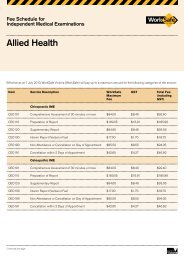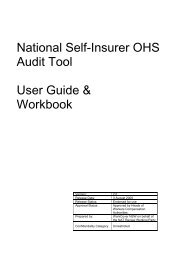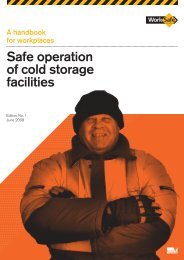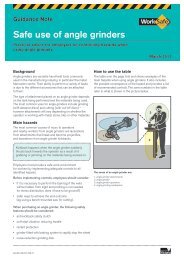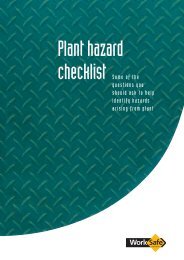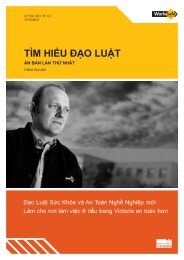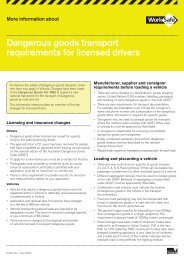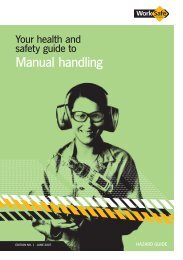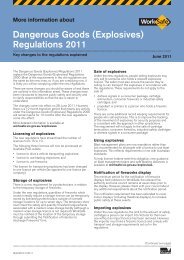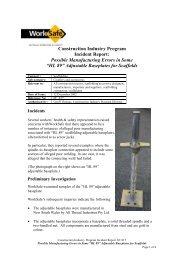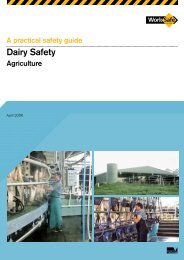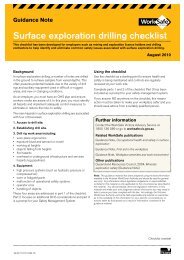Machinery and Equipment Safety - An Introduction - WorkSafe Victoria
Machinery and Equipment Safety - An Introduction - WorkSafe Victoria
Machinery and Equipment Safety - An Introduction - WorkSafe Victoria
Create successful ePaper yourself
Turn your PDF publications into a flip-book with our unique Google optimized e-Paper software.
RISK CONTROL OF MACHINERY<br />
AND EQUIPMENT HAZARDS<br />
2.3 RISK CONTROL OF NON-MECHANICAL HAZARDS<br />
The first step in selecting suitable <strong>and</strong> effective controls for non-mechanical<br />
hazards is to underst<strong>and</strong> the nature of emissions that can be released by<br />
machinery <strong>and</strong> equipment in the workplace, where those emissions collect<br />
<strong>and</strong> the way they may cause harm.<br />
• Separating people from non-mechanical hazards is necessary where the<br />
emission cannot be controlled at the source through elimination or substitution.<br />
Hazardous machinery <strong>and</strong> equipment emission controls rely largely on isolation<br />
of people from the hazardous emission.<br />
Hoods, lids, covers or impervious guards (solid barriers that prevent escape<br />
of the emission) can serve to contain a number of different types of emissions<br />
within machinery or equipment.<br />
For potentially harmful substance exposures from machinery <strong>and</strong> equipment,<br />
such as mist, fumes, vapour or dust, <strong>and</strong> where it is not reasonably practicable<br />
to control the emission at its source, ventilation <strong>and</strong> extraction systems are<br />
used to remove the hazardous atmosphere from the work environment.<br />
• For noise, guarding may also serve to mute noise emissions through application<br />
of sound absorbing materials. Other emissions such as lasers, ultra-violet light,<br />
bright light or welding flash can also be safely screened to prevent potential<br />
harmful exposure.<br />
• Oil leaks from machinery or equipment may present a serious slip hazard.<br />
By preventing oil leaks through routine maintenance, or containing leaking<br />
oil with a drip tray or through spill containment strategies, the risk the hazard<br />
presents is controlled.<br />
Personal protective equipment<br />
Where it is not reasonably practicable for emissions to be controlled at their<br />
source or removed or reduced through effective ventilation, extraction or diversion,<br />
the use of personal protective equipment (PPE) as a final measure must be<br />
considered to ensure safety.<br />
PPE is a lower order control <strong>and</strong> can only be used where higher order controls<br />
are not reasonably practicable or are not totally effective.<br />
Selection <strong>and</strong> use of PPE requires careful consideration, as there are many<br />
different types that reduce the risk of injury of contact or exposure to a hazard.<br />
Incorrect use of PPE or purchasing inappropriate PPE can contribute to serious<br />
workplace incidents.<br />
PPE that is uncomfortable, restrictive or heavy may create secondary hazards, <strong>and</strong>,<br />
as a result, constant supervision may be necessary to ensure it is used effectively.<br />
Ear muffs.<br />
Gloves.<br />
Particle half face respirator.<br />
Welding mask.<br />
<strong>Safety</strong> glasses.<br />
WORKSAFE VICTORIA / MACHINERY AND EQUIPMENT SAFETY – AN INTRODUCTION 13




